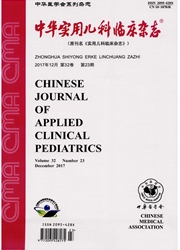

 中文摘要:
中文摘要:
目的研究浆细胞样树突状细胞(pDC)在过敏性紫癜(HSP)患儿外周血和肾脏组织中的表达和分布情况,探讨pDC在紫癜性。肾炎发病中的作用。方法40例HSP患儿,其中急性期28例,缓解期12例,分离患儿外周血单个核细胞,流式细胞术检测pDC的表达;设立正常对照组(15例)。同时抽提外周血总RNA并反转录为cDNA,以实时荧光定量PCR法检测患者组和正常对照组趋化因子干扰素γ诱导蛋白10(CXCL10)、CC类趋化因子配体5(CCL5)及相应受体CXC亚家族趋化因子受体3(CXCR3)、趋化因子受体5(CCR5)mRNA的定量表达水平(以2-△△Ct值表示)。应用免疫组织化学技术,观察8例行肾活检患者肾脏组织中pDC的分布;设立正常对照(3例)。结果HSP急性期患者外周血pDC表达的百分数为0.051±0.039,低于缓解期的0.181±0.082和正常对照组的0.166±0.079(P〈0.0001)。HSP患者外周血高表达CXCL10、CCL5,而低表达CXCR3、CCR5。正常对照肾脏组织未见pDC浸润,而紫癜性肾炎患者pDC呈局灶节段分布于肾小球系膜区。结论pDC在HSP患儿中表达异常,紫癜性肾炎的发生可能与外周血中pDCs在趋化因子作用下向肾组织的迁移,引起局部炎性反应有关。
 英文摘要:
英文摘要:
Objective To investigate the expression and distribution of plasmacytoid dendritic cells(pDC) in peripheral blood and renal tissues in children with Henoch-Schonlein purpura(HSP) , and explore the role of pDCs in the pathogenesis of Henoch-Schonlein purpura nephritis(HSPN). Methods Among the 40 children with HSP,28 ca- ses were in the active phase( renal biopsy performed in 8 cases of them)and the other 12 in remission phase. Peripheral blood mononuclear cells were isolated, and the expression of pDC was detected by flow cytometry. The normal control group was established (n = 15). Total RNA of peripheral blood was extracted and transcripted into cDNA. Sybr green dye based real-time quantitative PCR method was used to compare the expression( indicated as 2-△Ct value) of CXC motif chemokine 10 (CXCL10) , CC chemokine ligand 5 ( CCL5 ) , chemokine CXC subfamily receptor 3 ( CXCR3 ) , CC chemokine receptor 5 ( CCR5 ) in children with HSP and those in the controls. Immunohistochemistry labeling technique was used to detect the distribution of pDC in renal tissues from renal biopsy, and the normal controls were established ( n = 3). Results The expression percentage of pDC in peripheral blood in active phase was 0.051 ± 0. 039, signi- ficantly lower than those in remission phase (0.181 ±0. 082) and the normal controls (0. 166 ± 0. 079 ) ( P 〈 0. 000 1 ). Chemokines genes CXCL10 and CCL5 were overexpressed in peripheral blood ceils of acute phase HSP children,but chemokine receptors CXCR3,CCR5 were lowly expressed compared with normal controls. There was almost no expres- sion of pDC in the normal control renal tissues, while pDC was infiltrated in glomeruli of HSPN children. Conclusions The number of pDC and chemokines' expression in peripheral blood is abnormal ,and the pathogenesis of nephritis may be involved with the pDC in peripheral blood to migrate to the renal tissues.
 同期刊论文项目
同期刊论文项目
 同项目期刊论文
同项目期刊论文
 期刊信息
期刊信息
